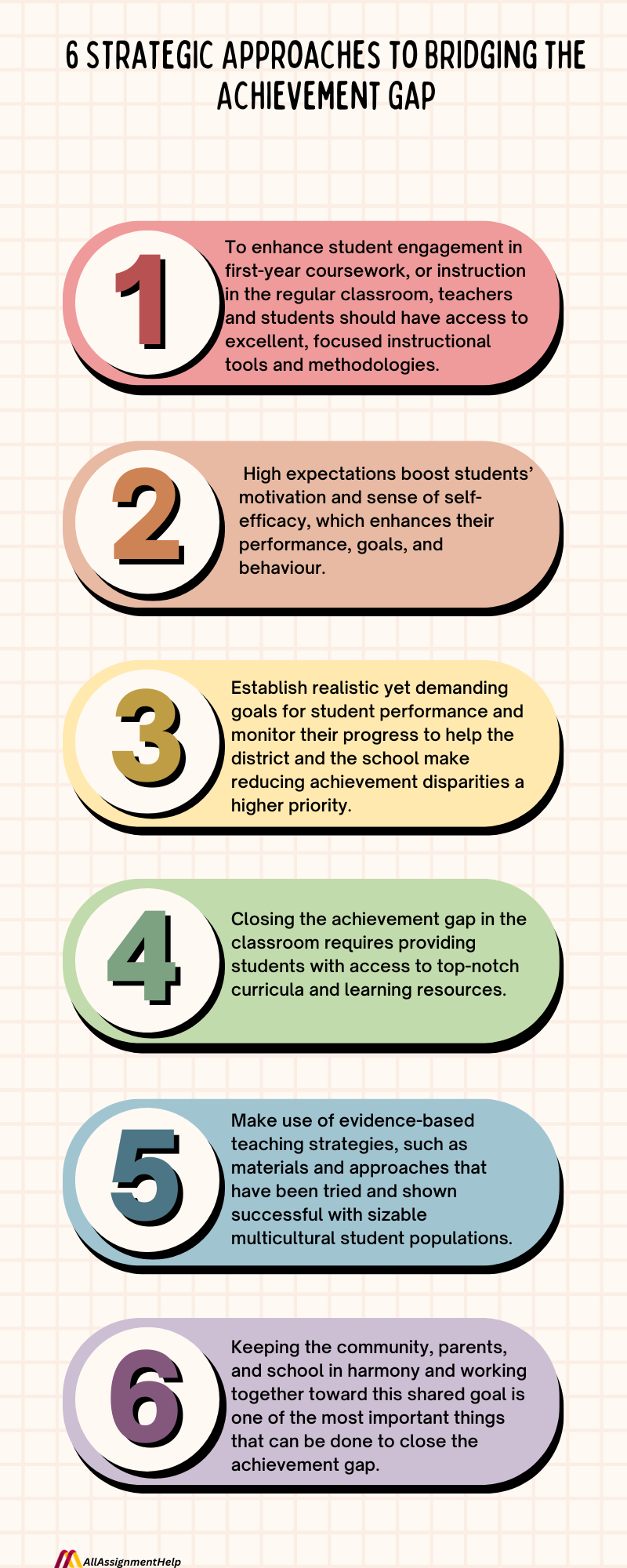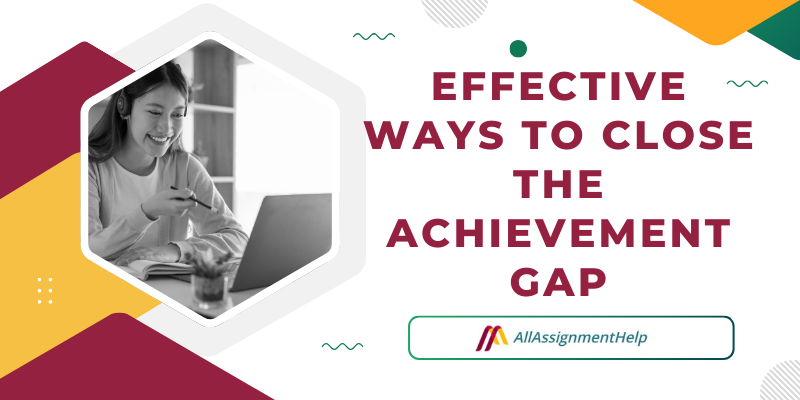Table of Contents
Just as each student is different, so are the situations that lead them to take class. Disparities in language, culture, financial background, gender identity, and other factors present unique difficulties for students, both as individuals and as broader demographic groupings. Access to school has not benefited all students equally because of these obstacles. The achievement gap refers to the ongoing disparity in performance levels among various groups of students.
Finding and closing these achievement gaps has long been a priority for educational institutions, government initiatives, and schools. Experts at AllAssignmentHelp present some essential facts about the achievement gap, the approaches various educational agencies take to bridge the gaps, and practical tactics that all educational institutions can adopt.
What Is the Achievement Gap?
When students’ performance differs from what is expected of them and what they have learned, this is known as an achievement gap. At a broader level, achievement gaps refer specifically to the disparities in test scores between two student groups classified by a certain demographic, such as socioeconomic status, gender, or race.
To ascertain whether the difference between two groups is significant, achievement gaps are computed by comparing their average scores. There can be a difference in arithmetic proficiency between white kids and pupils from ethnic minorities, or in reading proficiency between boys and girls.
Addressing and closing the achievement gap is crucial to enhancing academic performance among students from diverse demographics. One effective way to support students in overcoming learning challenges is by utilizing resources such as online assignment help, which provides personalized assistance and bridges educational disparities.
Who is Affected by the Achievement Gap?
The achievement gap impacts schools, communities, teachers, and different student groups. It implies the ongoing differences in academic achievement and opportunity across various learner groups. The groups most impacted by the educational gap are listed below:
- Students from Low-Income Families
- Minority and Underrepresented Groups
- Students with Learning Disabilities or Special Needs
- English Language Learners
- Teachers and Educators
- Schools and Educational Institutions
- Communities and Society at Large
- Parents and Families
The achievement gap has a significant impact on teachers, schools, families, and entire communities along with individual young people. To guarantee that all students have equal access to high-quality education, resources, and opportunities, policymakers, educators, communities, and families must work together to address these gaps.
To support students in overcoming challenges related to the achievement gap, online coursework services can play a vital role. They ensure that students can get the guidance they need at their convenience. So, if you’re facing academic hurdles, don’t hesitate to seek help when necessary.
Read Also: British English vs. American English: Key Differences Explained
Strategic Approaches to Bridging the Achievement Gap
An important issue in education is the achievement gap, which is the difference in academic performance between different students.
The difference in academic performance between different students, or the achievement gap, is a significant problem in education. Learners with learning difficulties, as well as those from marginalized and low-income families, often lag behind their peers. If teachers help close the achievement gap, it is possible to ensure that every child gets the education they are entitled to. Here are some doable tactics to help educators reduce the success gap in the classroom:

Focused Instruction
To enhance student engagement in first-year coursework, or instruction in the regular classroom, teachers and students should have access to excellent, focused instructional tools and methodologies.
It should go without saying that students need more time with their teacher the more they struggle. Therefore, extending the amount of time spent in class is one strategy that, when applied, can help close the accomplishment gap.
Although the instructor chooses how to give the lesson, it should be explicit, supported, and focused on the requirements and learning preferences of the students. Undoubtedly, it will be more detailed, repeated, and intense.
Establish high expectations
Having high standards allows students to perform at high levels rather than “demonstrating knowledge down” to them. The lowest disparities tend to occur at schools that promote cultures of high standards and solid teacher-student interactions. High expectations boost students’ motivation and sense of self-efficacy, which enhances their performance, goals, and behaviour. Assure that students have access to the resources they need to achieve while establishing a demanding curriculum that is in line with and founded on accepted standards.
Set goals and monitor your progress
Establish realistic yet demanding goals for student performance and monitor their progress to help the district and the school make reducing achievement disparities a higher priority. To find out how each student is doing, where they are falling behind, and how teachers can help, use formative assessments. Determine which subjects children are excelling at and where educators should concentrate their efforts.
For instance, if you are enrolled in online classes and are unsure about your performance due to multitasking, seeking assistance from professionals can be an ideal solution. With the help of these experts, you can keep track of your progress and work on areas where you may be falling behind. A simple approach, such as asking these experts, can you take my online class for me? can provide you with personalized solutions to bridge learning gaps. Additionally, maintaining open communication about your progress can empower you to identify areas for improvement and achieve your academic goals more effectively.
Read Also: Ways to Write a Winning College Student Resume
Make High-Quality Courses and Resources Available
Closing the achievement gap in the classroom requires providing students with access to top-notch curricula and learning resources. Regardless of their backgrounds, it’s a fantastic approach to guarantee that all students receive the same education and succeed academically. Making sure every kid has access to top-notch resources is one way that educators may work to reduce the achievement gap. These could consist of:
- Textbooks and online resources
- Tools for multimedia
- To increase student engagement and a sense of connection to the material, include pertinent materials in your lessons.
To ensure that pupils learn at the same time, make sure you divide the materials in the classroom equally.
Make use of evidence-based education
Make use of evidence-based teaching strategies, such as materials and approaches that have been tried and shown successful with sizable multicultural student populations. Performance data should provide continuous support for evidence-based learning programs so that teachers may more accurately evaluate students’ development and guide their lessons.
Building a bond between the families and the school
Keeping the community, parents, and school in harmony and working together toward this shared goal is one of the most important things that can be done to close the achievement gap. Students’ academic success will surely be impacted by the involvement of their parents, namely the family.
Even though many tactics are general, some might be better suited to a certain student group, grade level, or opportunity gap. It’s critical to address the unique needs of every kid since every accomplishment gap varies depending on the context and the relationship. Giving students access to programs that let them freely express their thoughts and determine their objectives might make them feel more successful, powerful, and driven.
When that assistance is evaluated against necessary standards, guidelines, and expectations, students are more capable of taking charge of their education and filling in the gaps.
One way to support students in overcoming academic gaps is by utilizing specialized services like assignment help services for particular subjects such as math, stats assignment help and more. These services are designed to provide guidance on complex statistical concepts, improve comprehension, and offer clarity on challenging assignments. With personalized support tailored to each student’s unique learning needs, they empower students to develop better problem-solving skills, meet learning goals, and improve their academic performance.
Read Also: High Scoring History Research Topics For You
FAQs
| Why is the achievement gap a problem? It limits opportunities for students to succeed academically and access quality education, impacting individuals, families, schools, and entire communities. |
| What can families and communities do to reduce the gap? Families and communities can support their children by engaging in their education, providing resources, and promoting equal access to quality programs and opportunities. |
| How can parents support their children in overcoming the achievement gap? Parents can engage in their child’s education by providing a supportive learning environment and maintaining consistent communication with teachers. |
